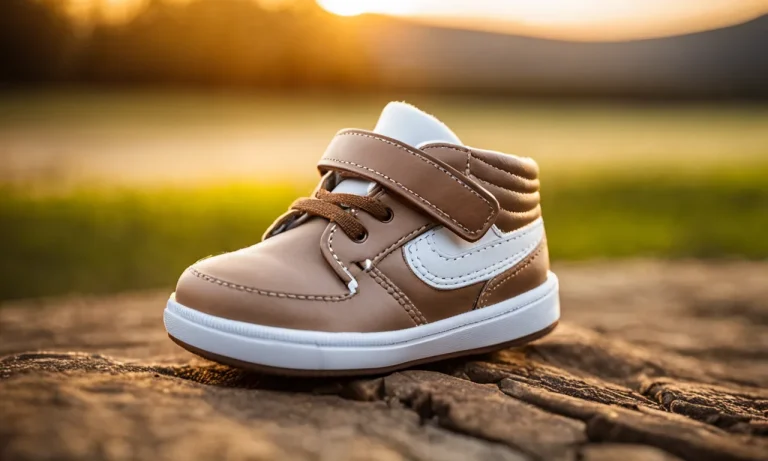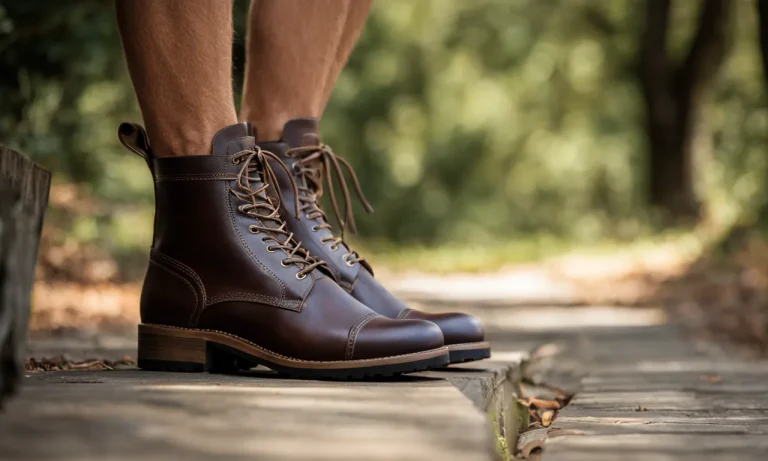If you’re looking to ramp up your exercise routine, you may be debating between a cross trainer and running shoes. Both have their benefits for cardio, strength training, and weight loss. In this comprehensive guide, we’ll compare cross trainers vs running shoes to help you decide which option is best for your fitness goals and preferences.
If you’re short on time, here’s a quick answer: Cross trainers are more versatile for full-body cardio and strength training, while running shoes are ideal if you want to focus on improving your running pace and endurance.
Key Differences Between Cross Trainers and Running Shoes
Intended Use and Benefits
Cross trainers and running shoes are designed for different purposes. Cross trainers are versatile shoes that are suitable for a variety of exercises, including weightlifting, aerobics, and cross-training workouts.
They provide support for lateral movements and offer stability for multidirectional activities. On the other hand, running shoes are specifically designed for running and provide cushioning and support for forward motion. They are lightweight and have a flexible sole to enhance running efficiency.
Workout Types and Muscles Targeted
Cross trainers are ideal for workouts that involve a combination of activities, such as circuit training or HIIT (High-Intensity Interval Training) workouts. They are designed to engage multiple muscle groups and provide stability for quick transitions between exercises.
Running shoes, on the other hand, are tailored for running and primarily target the muscles in the legs and feet used for forward propulsion. They offer cushioning to absorb the impact of running and protect the joints.
Cushioning and Stability
When it comes to cushioning, cross trainers typically have more cushioning in the midsole than running shoes. This extra cushioning helps absorb shock during multidirectional movements and provides support for lateral movements.
Running shoes, on the other hand, have cushioning focused on the heel and forefoot to provide shock absorption during the repetitive motion of running. In terms of stability, cross trainers have a wider base and more lateral support to prevent ankle rolling during side-to-side movements, while running shoes have a narrower base to allow for a more natural stride.
Weight and Breathability
Weight and breathability are important factors to consider when choosing between cross trainers and running shoes. Cross trainers tend to be heavier than running shoes due to their added support and cushioning, which can be beneficial for certain exercises that require stability.
Running shoes, on the other hand, are lighter to enhance running performance and reduce fatigue. In terms of breathability, both types of shoes offer breathable materials, but running shoes may have more extensive ventilation to help keep the feet cool during intense workouts or long runs.
Ultimately, the choice between cross trainers and running shoes depends on the specific exercise routine and individual preferences. It’s important to consider the intended use, workout types, cushioning and stability needs, as well as weight and breathability when making a decision.
It may also be helpful to try on both types of shoes and test them out in your preferred workout environment to see which one feels more comfortable and supportive for your needs.
How to Choose: Cross Trainer vs Running Shoe
When it comes to choosing the right footwear for exercise, the decision between a cross trainer and a running shoe can be a tough one. Both options have their own unique features and benefits, so it’s important to consider a few key factors before making your choice.
In this article, we’ll explore how to choose between a cross trainer and a running shoe based on your fitness goals, training preferences, foot type and stride, as well as budget and brand reputation.
Consider Your Fitness Goals
The first step in choosing between a cross trainer and a running shoe is to consider your fitness goals. Are you primarily focused on cardio workouts, or do you also incorporate strength training into your routine?
If you’re looking for a versatile shoe that can support a variety of activities, including weightlifting and high-intensity interval training (HIIT), a cross trainer might be the better option. On the other hand, if running is your main form of exercise or you’re training for a specific race or event, a running shoe specifically designed for long-distance running might be more suitable.
Identify Your Training Preferences
Another important factor to consider is your training preferences. Do you prefer to mix up your workouts with a combination of different exercises, such as running, cycling, and weightlifting? If so, a cross trainer with a multi-purpose sole and good stability may be the best choice, as it can provide support and cushioning for a range of activities.
However, if you’re a dedicated runner and spend most of your time pounding the pavement, a running shoe with specialized features, such as extra cushioning and support in the midsole and a lightweight design, may be more suitable.
Analyze Your Foot Type and Stride
Your foot type and stride play a crucial role in determining the right footwear for you. It’s important to understand whether you have a neutral, pronated, or supinated foot type and choose a shoe that provides the appropriate level of support and stability.
If you have flat feet or tend to overpronate (your foot rolls inward excessively), a cross trainer with good arch support and motion control features may be ideal. Conversely, if you have high arches or underpronate (your foot rolls outward), a running shoe with extra cushioning and flexibility may be more suitable.
Factor in Budget and Brand Reputation
Lastly, it’s important to factor in your budget and brand reputation when choosing between a cross trainer and a running shoe. While there are affordable options available in both categories, it’s worth investing in a high-quality shoe that will provide the necessary support and durability for your workouts.
Research different brands and read reviews from reputable sources to ensure you’re choosing a shoe from a trusted manufacturer. Websites like Runner’s World and Self can provide valuable insights and recommendations to help you make an informed decision.
Best Cross Trainer and Running Shoe Models
Top Cross Trainers for Men and Women
When it comes to choosing the best cross trainer, there are several top models that both men and women can consider. One popular option is the Nike Metcon 5, which is known for its durability and versatility.
It provides excellent support for weightlifting and also offers cushioning for cardio exercises. Another great choice is the Reebok Nano X, which is praised by athletes for its stability and comfort. With its flexible outsole and breathable upper, it is suitable for a variety of workouts.
For women, the Adidas Ultraboost is a highly recommended cross trainer. It offers a responsive and cushioned ride, making it ideal for running and other high-impact activities. Another option is the New Balance Fresh Foam 1080v10, which provides excellent support and a plush feel for all-day comfort.
It’s important to note that the best cross trainer for you will depend on your specific needs and preferences. It’s always a good idea to try on different models and see which one feels the most comfortable and supportive for your feet.
Best Running Shoes for Different Types of Runners
Choosing the right running shoe is crucial for a comfortable and injury-free running experience. Here are some top models for different types of runners:
- Neutral Runners: For those with a neutral pronation, the Brooks Ghost 13 is a popular choice. It offers a combination of cushioning and responsiveness, perfect for long-distance runs.
- Overpronators: If you have overpronation, the ASICS Gel-Kayano 27 is a reliable option. It provides excellent stability and support to prevent excessive inward rolling of the foot.
- Underpronators: Underpronators, or supinators, can benefit from the Nike Air Zoom Pegasus 37. It offers a responsive and cushioned ride, providing the necessary support for those with high arches.
Remember, these are just a few examples of top running shoe models. It’s important to consider factors such as your foot type, running style, and any specific needs or preferences you may have. Visiting a specialized running store or consulting with a podiatrist can also be helpful in finding the perfect running shoe for you.
Proper Use and Care Tips
Breaking in New Cross Trainers and Running Shoes
When you purchase a new pair of cross trainers or running shoes, it’s important to break them in properly to avoid discomfort and potential injuries. Start by wearing them for short periods of time, gradually increasing the duration over a few days or weeks.
This allows your feet to adjust to the shoes and prevents blisters or soreness. Remember, a good fit is essential for both types of shoes. If they feel too tight or too loose, consider getting a different size or trying a different brand.
Ideal Surfaces and Conditions
Both cross trainers and running shoes are designed to be used on different surfaces and in various conditions. Cross trainers are versatile and can be used on different indoor surfaces such as treadmills, gym floors, or cross-training machines.
On the other hand, running shoes are specifically designed for outdoor running on different terrains like roads, trails, or tracks. It’s important to use the appropriate shoe for the specific activity to ensure optimal performance and minimize the risk of injuries.
Cleaning and Replacement Frequency
Maintaining the cleanliness of your shoes is crucial for their longevity and odor prevention. To clean your cross trainers or running shoes, remove the laces and insoles, then gently scrub the surface with a soft brush and mild soap. Rinse with water and let them air dry.
It’s recommended to clean them regularly, especially if you use them frequently or in dirty conditions. As for replacement, a general guideline is to replace cross trainers and running shoes every 300-500 miles or when you notice signs of wear and tear such as a worn-out outsole or decreased cushioning.
This can vary depending on your usage and running style, so it’s important to monitor the condition of your shoes.
Cross Trainer and Running Shoe Workouts
Sample Cross Trainer Workout Routine
If you’re considering using a cross trainer for your exercise routine, you’ll be pleased to know that it offers a wide range of benefits. These machines provide a low-impact workout that is gentle on your joints, making them ideal for individuals with joint issues or those recovering from an injury.
A sample cross trainer workout routine might include a warm-up period followed by intervals of high-intensity and low-intensity exercises. For example, you could start with a 5-minute warm-up at a moderate pace, then increase the resistance and speed for 1 minute before returning to a lower intensity for 2 minutes.
Repeat this cycle for a total of 20 minutes, and then finish with a 5-minute cool-down.
Remember to listen to your body and adjust the intensity and duration of the workout according to your fitness level and goals. It’s always a good idea to consult with a fitness professional or trainer to customize a cross trainer workout routine that suits your needs.
Beginner Running Routine with Running Shoes
If you prefer running as your primary form of exercise, investing in a good pair of running shoes is essential. Running shoes are specifically designed to provide cushioning and support, reducing the impact on your joints and preventing injuries.
A beginner running routine with running shoes might start with a combination of walking and jogging. Begin with a 5-minute warm-up walk, then alternate between 1 minute of jogging and 2 minutes of walking for a total of 20 minutes.
Gradually increase the jogging intervals and decrease the walking intervals as your fitness level improves.
It’s important to note that running can be more high-impact than using a cross trainer, so it’s crucial to build up your endurance and strength gradually to avoid overexertion or injury. Make sure to stretch before and after your runs, and listen to your body to avoid pushing yourself too hard.
Adding Both to a Comprehensive Program
While both cross trainers and running shoes offer unique benefits, combining them in a comprehensive exercise program can provide even greater results. By incorporating both types of workouts into your routine, you can enjoy the advantages of low-impact cardio training on the cross trainer while also improving your running endurance and strength.
For example, you could alternate between using a cross trainer and running on different days of the week. This allows your body to recover from the impact of running while still maintaining your cardiovascular fitness with the cross trainer.
It’s a great way to add variety to your workouts and prevent boredom.
Remember, always prioritize safety and listen to your body. If you experience any pain or discomfort during your workouts, it’s important to seek medical advice or consult with a fitness professional.
For more information on cross trainers and running shoes, you can visit websites such as Runners World and Shape. These sites provide valuable resources and expert advice on fitness equipment and workout routines.
Conclusion
In summary, choosing between a cross trainer vs running shoe comes down to your specific goals and workout preferences. Cross trainers are best for varied, full-body training, while running shoes are optimal for logging miles and improving pace.
Consider factors like your foot type, typical surfaces, fitness objectives, and budget to decide which is the better choice for you. With the proper pair that fits your needs, you’ll be off to a great start in ramping up your cardio, endurance, and strength training.
We hope this detailed comparison of cross trainers vs running shoes has helped you decide which option may be best for your upcoming workouts. Let us know if you have any other fitness equipment questions!






